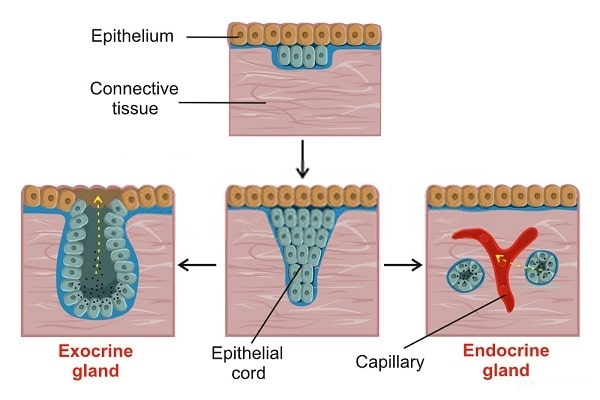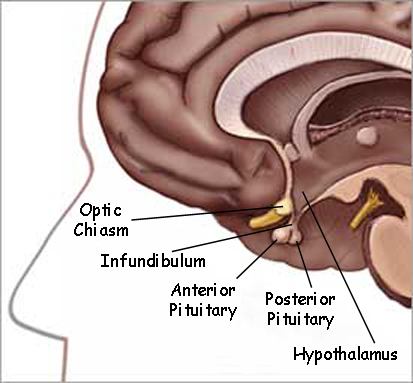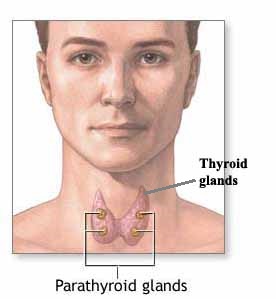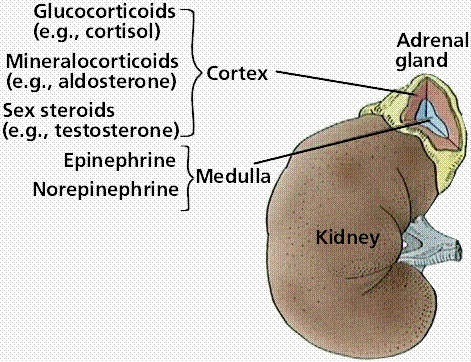Glands are the secretory organs located at specific sites in the body. They contain secretory tissue and secrete hormones, enzymes, and other secretions vital for regulating body physiology.
There are two types of glands, as
Exocrine glands
- Salivary glands
- Mucous glands
- Lachrymal glands
- Pancreatic gland
- Ceruminous glands (sweat glands and mammary glands).
Endocrine glands
- Pituitary gland
- Thyroid gland
- Parathyroid gland
- Adrenal gland
- Pineal gland
- Thymus gland
Exocrine glands secrete enzymes that act as biocatalysts to speed up the biochemical reactions.
Meanwhile, the endocrine glands secrete hormones that act as chemical messengers and are involved in the body’s homeostasis.
These glands can be scientifically differentiated based on their structures, location, and secretions.
Exocrine glands

- These glands secrete their contents into a particular region of the body.
- The secretion located in the core of the gland is carried through a duct and released at the site of action.
This secretion mostly has enzymes and other substances.
Examples of exocrine glands include
Salivary glands
- These are the glands located in the walls of the mouth. They secrete saliva and have the enzyme salivary amylase.
- This amylase helps digest carbohydrates in the mouth.
- Saliva also consists of lysosomal enzymes.
For more details, check out the article on the functions of saliva.
Mucous glands
- Mucous is a protective layer in the gastrointestinal tract. It helps to absorb the wear and tear during the digestion of food.
- Numerous mucous glands are present in the mucosa layer throughout the digestive tract. These glands secrete mucus.
Pancreas
The pancreas is a gland located near the digestive tract.
- Its exocrine portion secretes enzymes with pancreatic juice into the duodenum of the small intestine.
This pancreatic juice consists of digestive enzymes like pancreatic amylase, trypsin, and lipase. These enzymes digest carbohydrates, proteins, and fats, respectively.
Lachrymal glands
These are the glands present near the eye.
They secrete tears that have the lysosomal enzyme, salts, immunoglobulins, and water.
The lysosome enzyme helps to destroy microbes entering the eye.
Ceruminous glands
- These are modified sweat glands present in the outer ear.
- They secrete a sticky material called cerumen, which is sticky (ear wax).
- This ear wax contains lysosomal enzymes and immunoglobulins.
This helps to prevent the entry of insects and microbes into the ear.
Mammary glands
- Mammary glands are modified sweat glands present in the female reproductive system.
- These glands produce milk to nourish the newborn baby.
Types of Exocrine Glands
Exocrine glands can be divided into
- Simple and
- Compound glands
Simple exocrine glands
- These glands have a simplified structure without any branches in their anatomy.
Mucous-secreting glands of the large intestine are an example.
Compound exocrine glands

As seen in the image above, these glands have numerous branches in their anatomical structure.
All these branches collect the secretion and pour it out into the main branch. Examples of this type of gland include salivary glands.
Endocrine glands
These glands, unlike exocrine glands, do not have ducts to release their secretion.
Instead, the blood flowing through the glandular tissue carries away the secretion.
These secretions are called hormones and are meant to act quite far away from their origin source.
The entire set of endocrine glands is categorized separately as the endocrine system under 12 body systems.
Major Endocrine glands include
Hypothalamus
- This is a neuroendocrine gland, but some do not consider it a gland.
- Its secretion is meant to regulate the function of the pituitary gland, as listed in the table below.
| Sl. No | Hormone | Role |
|---|---|---|
| 1 | Growth hormone-releasing hormone | Growth hormone-releasing hormone |
| 2 | Growth hormone release inhibitory hormone | Restricts the release of growth hormone. |
| 3 | Gonadotropin-releasing hormone | Stimulates release of gonadotrophic hormones. |
| 4 | Prolactin release inhibitory hormone | Thyrotropin-releasing hormone |
| 5 | Thyrotropin-releasing hormone | Stimulates release of the thyrotrophic hormone. |
Pituitary Gland (below the hypothalamus)

- This is a gland located below the hypothalamus in the brain.
For more about its anatomy, refer to the pituitary structure.
The gland is differentiated into anterior and posterior glands and has definite secretions for each type, i.e.,
i) Anterior pituitary gland
Located in the front part of the pituitary
- Prolactin: Stimulates milk production in mothers.
- Somatotropin: A hormone that regulates the growth of the body and tissues.
- Luteinizing hormone: Stimulates ovulation (egg formation) in females and testosterone production in males.
- Thyroid-stimulating hormone: Stimulates the thyroid gland to produce T3 & T4 hormones.
- Adrenocorticotrophic hormone: Stimulates secretion of glucocorticoids and mineralocorticoid hormones.
- Follicle-stimulating hormone signals the formation of estrogen and progesterone by the female reproductive system.
ii. Posterior pituitary
It is present behind the front part of the pituitary, as shown in the diagram above.
- Vasopressin (antidiuretic hormone) controls water loss in the kidneys. So, it minimizes urine formation and saves water in the body.
- Oxytocin signals the uterus for delivery in pregnant women after the period of gestation. It also stimulates milk secretion in mothers.
Thyroid gland

This endocrine gland is situated in the throat region, as shown in the picture. It has a butterfly-like appearance.
It specifically produces two thyroid hormones named Tri-iodothyronine (T3) and thyroxine (T4).
Parathyroid glands
- These glands are present near the thyroid gland. They produce the hormone parathormone. This parathormone is involved in calcium regulation.
- Both thyroid and parathyroid glands are examples of types of glands in the neck.
Pancreatic islets
- The pancreas has both exocrine and endocrine functions.
- Its endocrine portion has islets of Langerhans cells. These islets secrete hormones that regulate the body’s glucose metabolism.
- The hormone insulin released enhances glucose uptake in the tissues and glycogen formation in the liver.
- At the same time, glucagon enhances the release of glucose from the liver into the blood.
- The hormone somatostatin inhibits the secretion of both insulin and glucagon hormones.
Adrenal glands
A pair of glands are located on the top of each kidney.
As shown in the image above, it has two regions.
- Adrenal cortex
- Adrenal medulla
The adrenal cortex portion secretes glucocorticoids and mineralocorticoids.
The adrenal medulla portion secretes nor-adrenalin. This is one of the neurotransmitters and is called a flight or fight hormone.
Pineal gland
- This is another gland located inside the brain.
- It secretes the hormone melatonin, a sleep hormone. It regulates sleep patterns and hence is called a natural body clock.
- One can see jet lag effects due to variations in its secretions.
You may also read-> Hormones in the human body.
Thymus gland
- This gland secretes the hormone thymosin, which is in the development of cell-mediated immunity.
Sex glands
Testes
- The testes secrete testosterone hormone.
- It is produced in males to a large extent and to a minimum extent in women.
- It signals male characteristics like the mustache, beard, heavy muscles, hoarse voice, courting behavior, etc.
Ovaries
- They produce two hormones, Estrogen and progesterone.
- They are secreted only in women and regulate the monthly reproduction cycle.
- Estrogen predominates in the first phase of the cycle, and progesterone in the 2nd half of the cycle.
Conclusion:
All the glands are located in distinct locations in the human body.
They regulate physiology to a large extent upon receiving the stimuli from the brain to do so.
Without their secretions, enzyme and hormone deficiency diseases can arise.
Besides the glands, individual cells also have the ability to secrete.
For example, sperms produce the Hyaluronidase enzyme. By this, sperm can swim in the uterine tissue to reach the ova.
Are You a Gland Expert? Test Your Knowledge About Human Glands!
Frequently asked questions and answers.
1. What gland has both endocrine and exocrine functions
The pancreas is the gland that has both functions.
The endocrine portion secretes hormones like glucagon and insulin hormones.
The exocrine portion secretes digestive enzymes like pancreatic lipase, trypsin, chymotrypsin, lipase, and nucleases.
2. How to remember endocrine glands and hormones
Endocrine glands and their hormones can be remembered from their location, shape, and role in physiology.

Thank you.
extremely helpful following a pituitary apoplexy which occurs in six people in 100,000 of the population. the info helps me with writing a book on the apoplexy
which left me in a dark place for four weeks before I recovered. it was as though someone had taken an eraser a rubbed out four weeks of my life.
it is very beneficial to me but I am still not yet clear with exocrine
@ Joseph Majur Wieu! Exocrine glands have a duct which carry the secretion to the desired place of action.Like pancreas secretes it digestive enzymes into intestine for digestion and nowhere else. While the endocrine part of it secretes hormones like insulin within itself which is carried away by blood to reach each and every part of the body for its action.
Its good to me
Very useful thank you so much sir.
You are owsome
Thanks very helpful
What type of glands are in the roof of our mouths?
This is a quiz question but I cannot find the answer
Thank you so much
Thanks you so much
Very nice, really helpful
Thanks for so much information about glands,i am also a patient of thyroid gland and i am following the medical advise of the physician. It takes a lot of time with healing.
I need some advise for quick healing.
@Ruben! Thyroid problem will be long standing if it immune related disorder. For better healing, it is good to have stress free life, physical activity and also good nutrition besides medication.
Superb.
I was very very useful.????
Thanx for giving information about glands
a gud source of info..
Wonderful website you have here but I was curious if you knew of any
community forums that cover the same topics talked about here?
I’d really like to be a part of online community where I can get
opinions from other experienced people that share the
same interest. If you have any suggestions, please let me know.
Cheers!
Thank you so much for this gland system
I love this, just straight to the point lesson.
thanks
Thanx for posting such an educative
information which has eased our studies
Thanks,..its so important for me..
It’s really great information
Thanks for the information. please keep it up.
this is such a meaningful and useful information which guide us to our assignment,test even an exam…..thank’s for it!!!
Its fantastic
Thanks
Easy to understand…Superb
Wow I really impress to get ur all information regarding HAP
easy and contain all information….thanks 4 all this.nice one
Very easy to Understand. But Firstly try to read Clearly.
Its great
It is very use ful to us…..
Very clever… Thanks for this I finished my homework….
Thank you so much for giving us the information about the glands in our body. It is such nice & helpful information. Hope that you will also give more information to us…
tell me about this question thank you sir
Nice it’s very easy to learn
Thanks for these information.
thank guyz for making this a reality
Excellent description of the endocrine glands and their functions. It really is helping me to learn they’re basic functions. Thanks for posting and helping to spread the knowledge that can help people learn how to heal themselves.
with out the endocrine and exocrine gland 2more glands available in the body any one tell me about that
thanks it has helped me alot….
Easiest form of studying
how many types of gland
GOOD INFORMATION
THANK YOU
I know that is good but not enough
Very helpful information..
Thank you it help complete my lesson note
Very nice information
Good……. but not enough for my #home_assingment
Thank you for easing my nursing assignment
Too good very useful for me. It helps me to complete my project on time.
THANK YOUUUUUUUU.
LOVE IT!!!!!!!!!!!!!!!!!
for me.
huwaaaaaa & great
~ THANK YOU so much ! ;))
its good information I like it very easy to learn
well, its good information but i want to know when they form in human body and when they start functioning
very useful very good but not enough………………….???????
information is very good just like a smart study
Adrenal gland produces adrenalin
good and useful information
which gland produces adrenaline
Adrenal medulla produces adrenalin in small proportions while it produces nor-epinephrine in large proportions.
adrenal gland
very useful,and good information. quite happy with the results ,would recommend others to make use of it.